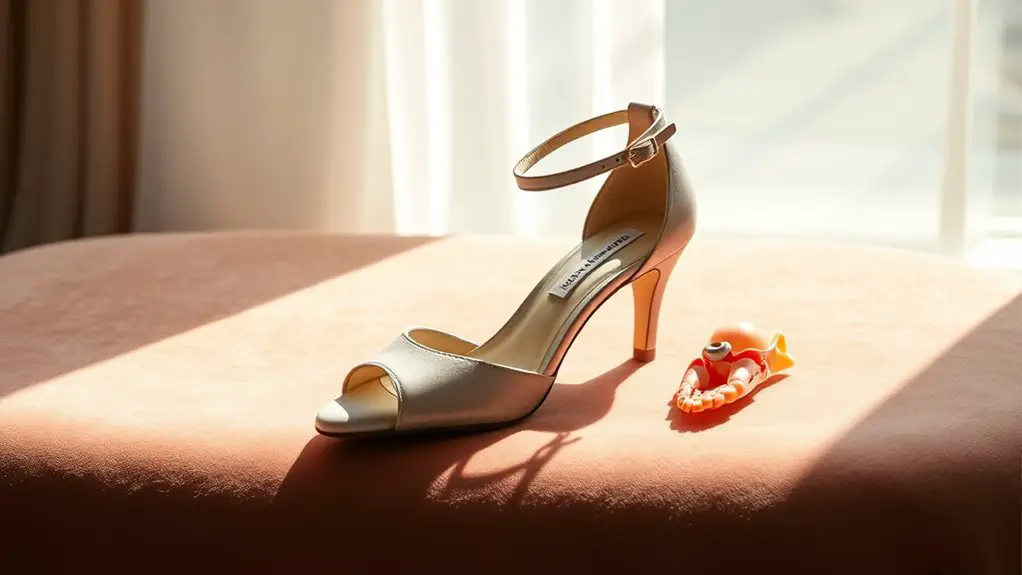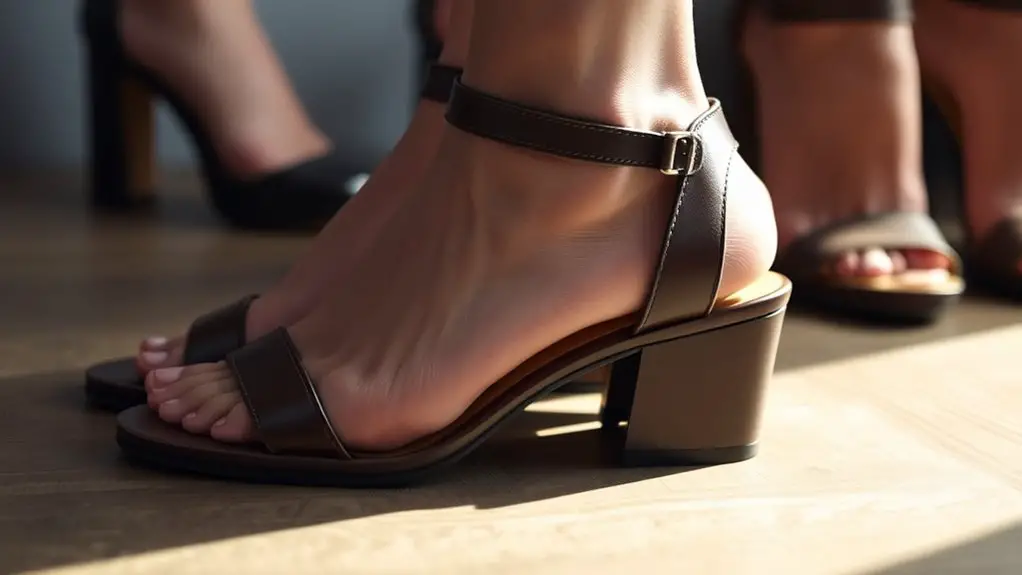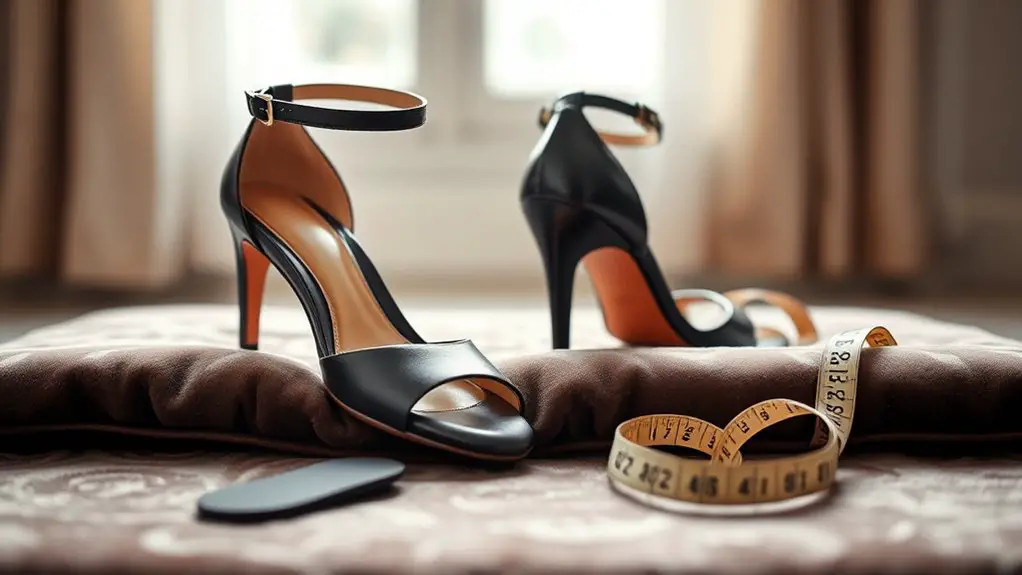When choosing heels with ankle issues, prioritize comfort and support. Opt for low heels (1-2 inches) to enhance stability and look for cushioned footbeds and arch support. Consider styles with ankle straps for added security and guarantee a proper fit to avoid discomfort. Block heels or wedges can help distribute weight better. Incorporating insoles and taking breaks while wearing heels can also improve comfort. There’s more to explore on how to effectively manage your ankle health while wearing heels.
Understanding Your Ankle Issues

How can you effectively assess your ankle issues before choosing the right heels? Start by understanding your ankle anatomy, which includes bones, ligaments, and tendons that support movement. Common injuries, such as sprains, fractures, or tendonitis, can greatly affect your ability to wear heels comfortably.
Begin with a self-examination: check for pain, swelling, or instability when moving your ankle. If you’ve experienced previous injuries, consider how they impact your current condition. Pay attention to any limitations in range of motion or balance, as these factors can guide your heel selection.
It’s also wise to consult a healthcare professional for a thorough assessment, especially if you’re unsure about your symptoms. They can provide insights tailored to your specific situation, helping you make informed decisions about heel styles that minimize risk and promote comfort. Understanding these aspects is vital for protecting your ankle health while enjoying fashionable options.
Prioritizing Comfort Over Style
When selecting heels, comfort should be your primary concern, especially with existing ankle issues. Cushioned footbeds, lower heel heights, and adjustable straps can markedly enhance your stability and reduce discomfort. Prioritizing these features will help you maintain both mobility and style without exacerbating your condition.
Cushioned Footbeds Matter
While style often takes precedence in footwear choices, prioritizing comfort through cushioned footbeds is vital, especially for those with ankle issues. Cushioned footbeds with advanced cushion technology provide the necessary support and comfort. They help absorb shock, reducing strain on your ankles. Additionally, proper arch support is critical; it aligns your feet and prevents discomfort.
| Feature | Benefit | Importance |
|---|---|---|
| Cushion Technology | Shock absorption | Reduces ankle strain |
| Arch Support | Foot alignment | Prevents discomfort |
| Flexibility | Natural movement | Enhances stability |
| Breathability | Comfort over long wear | Reduces foot fatigue |
Selecting heels with these features guarantees that comfort doesn’t take a back seat to style.
Opt for Lower Heels
Cushioned footbeds provide significant comfort, but the height of heels also plays an essential role in managing ankle issues. Opting for lower heel types can greatly enhance your heel stability, reducing the risk of strain on your ankles. Heels under two inches are generally recommended, as they distribute weight more evenly and minimize the angle of the foot. When selecting lower heel types, consider styles with a wider base, as they offer better support and balance. These design features can alleviate pressure on your ankles and contribute to overall comfort during wear. Prioritizing lower heels doesn’t mean sacrificing style; many fashionable options are available that also support your ankle health. Remember, comfort should always come first when addressing ankle concerns.
Choose Adjustable Straps
Choosing shoes with adjustable straps can greatly enhance comfort for those dealing with ankle issues. These straps provide a secure fit, allowing you to customize the tightness according to your comfort level. This can reduce the risk of instability and discomfort while walking.
| Type of Adjustable Strap | Benefits | Considerations |
|---|---|---|
| Buckle | Customizable fit | May require practice |
| Velcro | Easy to adjust | Less formal appearance |
| Elastic | Flexible movement | Limited adjustability |
| T-strap | Better ankle support | May not suit all styles |
| Ankle strap | Enhanced stability | Can limit range of motion |
Incorporating adjustable straps into your footwear can greatly improve your wearing experience, ensuring both comfort and support.
Choosing the Right Heel Height
When selecting heels with ankle issues, heel height plays a significant role in your comfort and stability. Low heels generally provide better support and reduce strain, while high heels can exacerbate existing problems. It’s vital to identify a suitable heel height that balances style and your specific ankle needs.
Low vs. High Heels
How do you determine the right heel height when dealing with ankle issues? First, consider the low heel benefits. Low heels typically offer better stability and distribute body weight more evenly, reducing strain on the ankles. They can enhance comfort during prolonged wear and minimize the risk of injury. In contrast, high heel risks can include increased pressure on the forefoot, reduced balance, and a higher likelihood of ankle sprains. If you have existing ankle problems, choosing low heels can greatly alleviate discomfort and support your overall foot health. Ultimately, your decision should prioritize comfort and stability over aesthetics, ensuring that your footwear complements your lifestyle without exacerbating any ankle issues.
Optimal Heel Height
Determining the ideal heel height involves careful consideration of your individual ankle condition and overall foot health. Generally, a heel height of 1 to 2 inches is recommended for maximum stability, as it provides a balance between style and comfort. Lower heels offer better ankle support, reducing strain during prolonged wear. If you prefer slightly higher heels, make sure they feature a wide base for improved heel stability and consider platforms to minimize the angle of your foot.
Avoid heels over 3 inches, as they can compromise ankle support and increase the risk of injury. Always prioritize comfort and functionality over aesthetics, and remember to test any new shoes on a flat surface to assess their impact on your ankle health.
Opting for Supportive Features

While selecting heels, prioritizing supportive features is essential, especially for those with ankle issues. Look for shoes that offer adequate arch support to help distribute weight evenly and reduce strain on your ankles. Additionally, features that promote ankle stability can greatly improve your comfort and reduce the risk of injury.
| Supportive Features | Benefits |
|---|---|
| Arch Support | Enhances weight distribution |
| Ankle Straps | Provides additional stability |
| Cushioned Footbeds | Reduces impact during walking |
Choose heels with a wider toe box, as this can help with balance. Heels that incorporate a platform can also lessen the angle of your foot, providing extra support. By focusing on these features, you’ll make a more informed decision that caters to your specific needs, ensuring both style and comfort.
Assessing the Shoe Material
Selecting the right shoe material is vital for those dealing with ankle issues. You’ll want to evaluate the balance between shoe flexibility and material durability. A flexible material can help accommodate your foot’s natural movements, reducing strain on your ankles. Look for options like soft leather or high-quality synthetic fabrics, which often provide the necessary give without sacrificing support.
However, durability is equally important. A shoe made from long-lasting materials can better withstand daily wear and tear, maintaining its structure over time. This is essential for preventing your ankles from rolling or twisting, which can lead to further injury.
When examining materials, also pay attention to the shoe’s weight; lighter materials can enhance comfort during wear. Ultimately, selecting a shoe with the right combination of flexibility and durability will greatly contribute to your overall ankle health while wearing heels.
Exploring Different Heel Styles

How do different heel styles impact your comfort and stability? The shape and width of heels play vital roles in how well you can manage your ankle issues. For instance, a block heel offers greater stability due to its wider base, distributing weight evenly and reducing the risk of ankle strain. Conversely, stilettos, with their narrow heel shapes, can exacerbate instability and discomfort, particularly for those with pre-existing ankle concerns.
Heel widths also greatly influence comfort; a wider heel can provide a more secure fit, minimizing the chance of rolling an ankle. Consider platform heels too, as they elevate the foot while maintaining a lower angle, reducing stress on your joints. Ultimately, choosing the right heel shape and width that aligns with your specific needs can greatly enhance your comfort and stability, allowing you to enjoy wearing heels without compromising your ankle health.
Importance of Proper Fit
Finding the right heel style is only part of the equation; proper fit is equally important for managing ankle issues. When selecting heels, focus on shoe sizing to guarantee your foot isn’t cramped or sliding. A shoe that’s too tight can exacerbate discomfort, while one that’s too loose may lead to instability, increasing the risk of injury.
Pay attention to heel width as well. A wider heel can provide better support and balance, minimizing strain on your ankles. It’s crucial to try on shoes at the end of the day when your feet are slightly swollen, as this will give you a more accurate sense of fit.
Don’t hesitate to consult size charts and, if necessary, explore half sizes to achieve the perfect fit. Prioritizing proper fit can greatly enhance your comfort and stability while wearing heels, ultimately safeguarding your ankles.
Incorporating Insoles and Cushions
When you’re dealing with ankle issues, incorporating insoles and cushions into your heels can considerably enhance comfort and support. Insoles benefits include improved arch support and shock absorption, which can reduce strain on your ankles. Many insoles are designed specifically for heel height, allowing you to maintain a stylish appearance while prioritizing your foot health.
Cushioning options vary widely, from gel inserts to memory foam pads, each offering unique advantages. Gel inserts provide targeted cushioning, while memory foam conforms to the shape of your foot, alleviating pressure points. Consider custom orthotics if you need a tailored solution that addresses your specific foot mechanics.
Tips for Wearing Heels With Ankle Issues
What strategies can you employ to wear heels comfortably despite ankle issues? First, consider heel alternatives like wedges or block heels, which provide more stability and distribute weight evenly. Opt for shoes with a lower heel height; this can reduce strain on your ankles. Look for styles that incorporate ankle support, such as those with straps or a built-in brace.
Additionally, prioritize fit—always try on your heels before purchasing, ensuring they don’t pinch or rub. If possible, choose materials with some stretch to accommodate any swelling.
When wearing heels for extended periods, take breaks to relieve pressure on your ankles. Utilize insoles designed for added cushioning and arch support, enhancing comfort. Finally, engage in ankle-strengthening exercises to improve stability and flexibility, which can make wearing heels more manageable. By implementing these strategies, you can enjoy wearing heels while minimizing discomfort and risk.
Frequently Asked Questions
Can I Wear Heels if I Have a History of Ankle Sprains?
If you’ve a history of ankle sprains, it’s essential to prioritize ankle support. Consider heel alternatives like wedges or block heels, which provide stability. Always consult a professional before making any footwear decisions to guarantee safety.
Are There Specific Brands Known for Ankle-Friendly Heels?
Yes, certain brands focus on comfortable designs and supportive features. Look for those that prioritize stability, like Clarks or Naturalizer, which often incorporate cushioning and wider bases to help minimize discomfort and enhance ankle support.
How Can I Break in New Heels Safely With Ankle Issues?
To break in new heels safely, prioritize heel comfort. Start with short durations, allowing for gradual adjustment. Gradually increase wear time, monitoring any discomfort, ensuring your ankles adapt without excessive strain or pain.
Do Ankle Braces Fit Comfortably Inside Heeled Shoes?
Imagine trying to fit a puzzle piece into the wrong spot; ankle braces often don’t fit comfortably inside heeled shoes. Consider shoe modifications to enhance ankle support, ensuring both comfort and stability while wearing heels.
What Exercises Can Strengthen My Ankles for Wearing Heels?
To strengthen your ankles for wearing heels, incorporate ankle stability exercises like balance drills and heel flexibility training through calf stretches. These will enhance your ankle support and flexibility, promoting comfort while wearing elevated footwear.



